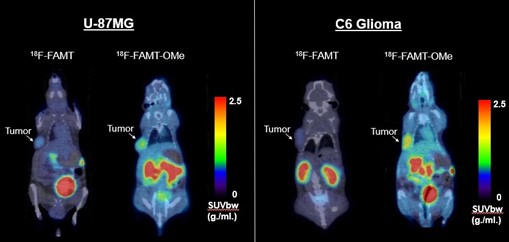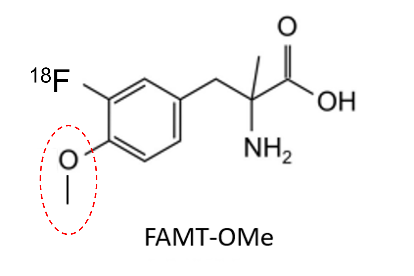Summary
- A New Candidate Compound for PET Diagnostics: Proposal for Integration into Your Pipeline
- Improved FAMT Compound Specific to LAT1, an Amino Acid Transporter Highly Expressed in Tumor Cells
- Resolved FAMT’s Kidney Accumulation Issue; Enhanced Tumor Accumulation Confirmed In Vivo
- New Synthesis Method: Overcame the Low Yield Issue of Traditional Methods, Significantly Increased Yield
- Proven to be Synthesizable Using Existing PET Reagent Synthesis Equipment
Technology Overview & Background
18F-FAMT is one of the PET diagnostic probes targeting the L-type amino acid transporter 1 (LAT1), which is specifically expressed in cancer cells. 18F-FAMT is regarded as an excellent probe because it accumulates only in malignant tumors and not in normal tissues or benign tumors. However, 18F-FAMT has the weaknesses of accumulating in the kidneys and being quickly washed out from tumors. The former issue is thought to be due to 18F-FAMT being taken up into the renal tubules via the organic anion transporter OAT1 present in the kidneys.
Additionally, this newly developed 18F-FAMT-OMe addresses the low synthesis yield issue of the original 18F-FAMT. 18F-FAMT is produced via labeling synthesis using 18F-F2 gas, but due to the low yield of 18F-F2 gas itself, the amount of 18F-FAMT that can be produced is limited. In contrast, this new technology employs a novel synthesis method using a coupling reaction. This method involves the synthesis of a labeled precursor with a pinacol ester as a leaving group and 18F-hydrogen fluoride (18F-HF), resulting in the high-yield production of the new compound 18F-FAMT-OMe. Furthermore, this synthesis route can be implemented using existing PET reagent synthesis equipment, making its introduction less challenging.
18F-FAMT is one of the PET diagnostic probes targeting the L-type amino acid transporter 1 (LAT1), which is specifically expressed in cancer cells. 18F-FAMT is considered an excellent probe that accumulates only in malignant tumors without accumulating in normal tissues or benign tumors.
Data
- The new 18F-FAMT-OMe technology was administered to model mice implanted with human glioblastoma cells (U-87MG) and rat glioma cells (C6 Glioma cells) to investigate its tumor accumulation properties. While the old 18F-FAMT technology showed low tumor accumulation, the new 18F-FAMT-OMe technology demonstrated significantly improved tumor accumulation (see figure below).
 |
Patents
WO2023/063154 A1(PCT/JP2022/037004)
Principal Investigator & Academic Institution
Tadashi Watabe; Associate Professor/Lecturer, Department of Radiology, Graduate School of Medicine, Osaka University, Department of Nuclear Medicine
Sadahiro Naka; Hospital, Osaka University, Department of Nuclear Medicine
Expectations
- We are seeking companies interested in adopting the new 18F-FAMT-OMe technology and developing it as a PET probe.
- This technology has already demonstrated high tumor accumulation in vivo and can be synthesized using existing PET reagent synthesis equipment, making it highly likely to reach the market quickly.
- The developers are experts in radiology and are prepared to provide the necessary information and knowledge for corporate development through joint research or intellectual property agreements (licensing agreements).
We are looking for companies interested in the commercialization and practical application of this technology through licensing. We can provide disclosure of unpublished data under a confidentiality agreement with Osaka University and facilitate meetings with the inventors. If you have any inquiries, please feel free to contact us.
Project.DA-04020



